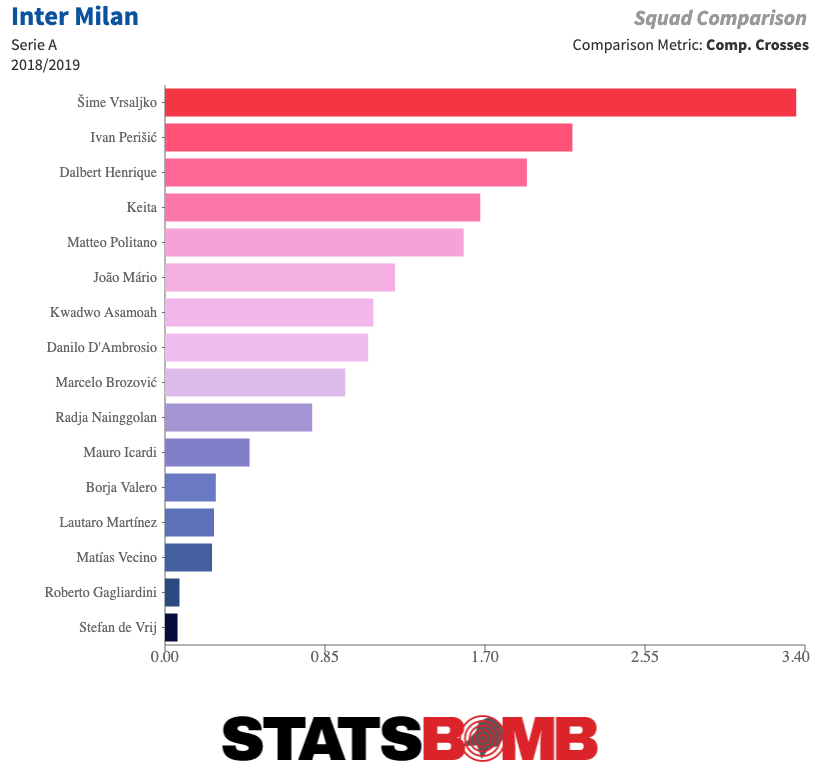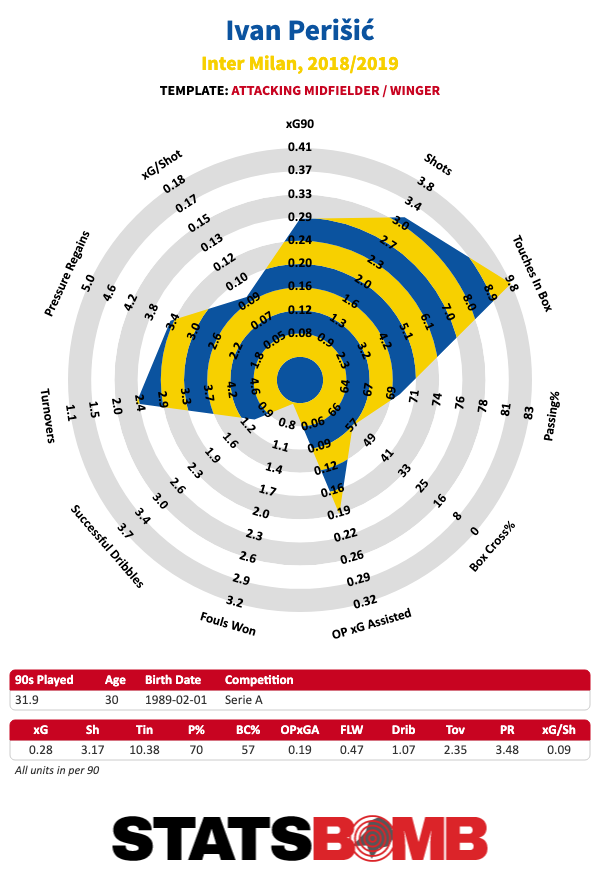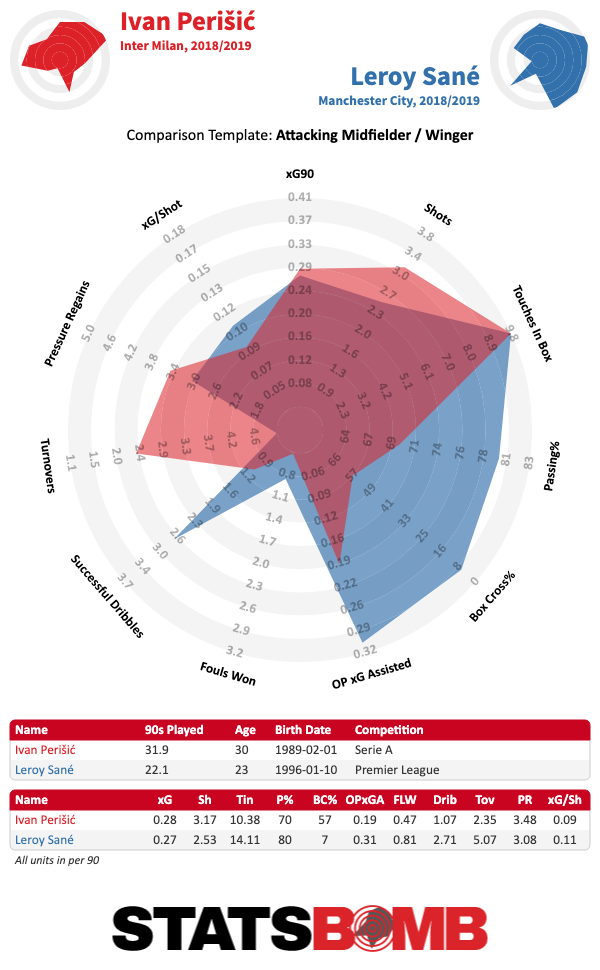If your club has just moved for Ivan Perišić, its transfer window has probably not gone according to plan. That is not exactly a slight against the World Cup finalist. At 30, he’s still a useful winger. It’s just that, well, he’s a winger. And it’s 2019. The story of Bayern Munich’s uninspiring summer loanee from Internazionale actually has very little to do with Perišić; it’s about football’s evolution in recent decades. This, in other words, is an article about crossing. Under Luciano Spalletti, Inter had a cross-heavy attack more commonly associated with relegation-threatened clubs. Over and over, balls were lofted into the box for an isolated Mauro Icardi (or whomever was replacing the striker during one of his periodic fallings out.) In 2018-19, crosses accounted for 32% of the average Serie A club’s passes into the box but 38% of Inter’s. The disparity becomes more glaring if you focus on Perišić. Crosses accounted for 57% of his completed passes into the box. The league average for his fellow attacking midfielders and wingers was less than half that: 27%. To the extent that crossing is still done, it is not really a winger-y skill. At Inter, however, Perišić and fellow winger Matteo Politano led the team in completed crosses. Even on a team that used wingers in this way, Perišić stood out: His 69 completed crosses represented nearly 150% of Politano’s total. Nice?  Being good at an efficient task, like converting shots, produces a clear statistical bump; being good at a fundamentally inefficient task, like crossing, produces a statistical muddle. Case in point: Ivan Perišić. He had a middling pass completion percentage and found teammates with a lower percentage of his crosses than thirteen other Inter regulars. This doesn’t mean he was one of the team’s weaker crossers. A winger tasked with chucking the ball into the box ad infinitum will always have a lower completion percentage than occasional crossers. Perišić is a prolific — and good crosser — last season. He just doesn’t have much to show for it.
Being good at an efficient task, like converting shots, produces a clear statistical bump; being good at a fundamentally inefficient task, like crossing, produces a statistical muddle. Case in point: Ivan Perišić. He had a middling pass completion percentage and found teammates with a lower percentage of his crosses than thirteen other Inter regulars. This doesn’t mean he was one of the team’s weaker crossers. A winger tasked with chucking the ball into the box ad infinitum will always have a lower completion percentage than occasional crossers. Perišić is a prolific — and good crosser — last season. He just doesn’t have much to show for it.  Crossing notwithstanding, Perišić hasn’t been a particularly noteworthy winger. Last season, he couldn’t beat defenders on the dribble or draw fouls. He had lots of touches in the box, but to little effect. He produced a respectable amount of expected goals, but that was largely a function of taking a high volume of low-value shots. (For good measure, Perišić scored fewer goals than expected.) This was a fairly typical season for Ivan. Other than the expected goals underperformance, he had the same season in 2017-18. StatsBomb supremo Ted Knutson found the same general profile in 2016-17. The last time Perišić was a remotely interesting player was in 2011-12 at Borussia Dortmund, when his game still had lots of dribbling and pass completion. Those fun days were a long time ago — an entire career, really. This is not to say that crossing can never produce a tactical advantage. If your club has Cristiano Ronaldo and he has continued to avoid process servers, lofting the ball where only his head can reach it is a serviceable strategy. This might explain why good clubs, after striking out on bigger targets, have so often looked to Perišić. You can talk yourself into his being useful on a dominant club. Jose Mourinho, near the end of his final summer of discontent with Ed Woodward, settled on the idea of Perišić as a crosser for Romelu Lukaku. (In this, Mourinho seemed to have a clearer read on Perišić than Lukaku, who is not actually that kind of big target man.) Similarly, as a key Bayern Munich transfer target saw their legs explode, the club turned to Perišić. Without wishing to be mean, he’s a major step down from Leroy Sané in a bad year:
Crossing notwithstanding, Perišić hasn’t been a particularly noteworthy winger. Last season, he couldn’t beat defenders on the dribble or draw fouls. He had lots of touches in the box, but to little effect. He produced a respectable amount of expected goals, but that was largely a function of taking a high volume of low-value shots. (For good measure, Perišić scored fewer goals than expected.) This was a fairly typical season for Ivan. Other than the expected goals underperformance, he had the same season in 2017-18. StatsBomb supremo Ted Knutson found the same general profile in 2016-17. The last time Perišić was a remotely interesting player was in 2011-12 at Borussia Dortmund, when his game still had lots of dribbling and pass completion. Those fun days were a long time ago — an entire career, really. This is not to say that crossing can never produce a tactical advantage. If your club has Cristiano Ronaldo and he has continued to avoid process servers, lofting the ball where only his head can reach it is a serviceable strategy. This might explain why good clubs, after striking out on bigger targets, have so often looked to Perišić. You can talk yourself into his being useful on a dominant club. Jose Mourinho, near the end of his final summer of discontent with Ed Woodward, settled on the idea of Perišić as a crosser for Romelu Lukaku. (In this, Mourinho seemed to have a clearer read on Perišić than Lukaku, who is not actually that kind of big target man.) Similarly, as a key Bayern Munich transfer target saw their legs explode, the club turned to Perišić. Without wishing to be mean, he’s a major step down from Leroy Sané in a bad year:  And so Bayern, needing to replace the departed Arjen Robben and Franck Ribéry on the wings, brought Perišić in on loan. To his credit, Perišić's legs have not exploded in the manner of Leroy Sané or Callum Hudson-Odoiï, and he’s nearly a decade older than both players. He plays nothing like Bayern’s other targets, but he’ll eat up minutes on one wing. If you’re feeling generous, you can almost see his crossing for Robert Lewandowski being mildly effectively. Crucially, he was available. This is the beautiful irony of Ivan Perišić: He’s been in high demand in recent years because the thing he’s good at just isn’t that valuable. In an alternate universe, Perišić would have spent the last couple seasons at Everton or maybe Watford, directing high balls at Troy Deeney’s ageing cranium. “Oh Watford,” we’d say. “They’re a little zany.” There is still room for good-but-not-great wingers in the game, but it’s normally at clubs with an outside chance of Europa League qualification. Ivan Perišić, however, has consistently played at and been a target for big clubs even as he ages. It’s nice work if you can get it.
And so Bayern, needing to replace the departed Arjen Robben and Franck Ribéry on the wings, brought Perišić in on loan. To his credit, Perišić's legs have not exploded in the manner of Leroy Sané or Callum Hudson-Odoiï, and he’s nearly a decade older than both players. He plays nothing like Bayern’s other targets, but he’ll eat up minutes on one wing. If you’re feeling generous, you can almost see his crossing for Robert Lewandowski being mildly effectively. Crucially, he was available. This is the beautiful irony of Ivan Perišić: He’s been in high demand in recent years because the thing he’s good at just isn’t that valuable. In an alternate universe, Perišić would have spent the last couple seasons at Everton or maybe Watford, directing high balls at Troy Deeney’s ageing cranium. “Oh Watford,” we’d say. “They’re a little zany.” There is still room for good-but-not-great wingers in the game, but it’s normally at clubs with an outside chance of Europa League qualification. Ivan Perišić, however, has consistently played at and been a target for big clubs even as he ages. It’s nice work if you can get it.
2019
Ivan Perišić: Bayern's Cross to Bear
By admin
|
August 19, 2019